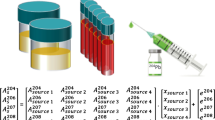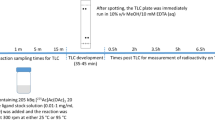Abstract
Objective
Phase 0 clinical studies, which are known as microdose trials, are expected to promote drug development and reduce development costs. The accelerator mass spectrometry (AMS) system is expected to play an important role in the microdosing tests, as it is a highly sensitive measurement system that can be used to determine the drug concentrations in these tests. Using the AMS system, we measured the background 14C-concentration in human blood and evaluated the data for use as a reference in microdose studies that administer 14C-labeled compounds in humans.
Methods
Blood samples of five healthy Japanese volunteers (three men, two women, median age 40.4 ± 9.8 years) were collected around the same time and just prior to when the subjects ate a meal (between 12:00 noon and 2:00 pm). Centrifugal separations of blood that was allowed to clot and the plasma were performed at 503 g for 2 min at 4°C. Background 14C-concentration for each of the samples was measured using the AMS system. The Institute of Accelerator Analysis, which is the first contract research organization in Japan that is capable of providing AMS analysis services for carbon dating and bioanalysis work, performed the AMS analysis.
Results
The mean 14C-concentration in blood was 1.613 ± 0.125 dpm/ml (men 1.668 ± 0.114 dpm/ml, women 1.514 ± 0.076 dpm/ml), in clots 2.373 ± 0.087 dpm/ml (men 2.381 ± 0.101 dpm/ml, women 2.357 ± 0.060 dpm/ ml), and in plasma 0.648 ± 0.049 dpm/ml (men 0.647 ± 0.059 dpm/ml, women 0.649 ± 0.032 dpm/ml). The coefficient variation (CV) for blood was 7.8% (men 6.9%, women 5.0%), for clots 3.7% (men 4.3%, women 2.5%), and for plasma 7.6% (men 9.1%, women 4.9%). The 14C-concentrations of the clot and blood were higher than those of plasma. The 14C-concentrations in the blood and plasma were slightly different between individuals when compared with the values for the clot, although the differences were quite small, with a CV value less than 7.8%.
Conclusions
Even though the 14C-concentration differed only slightly between individuals, 14C-concentrations of the clot and blood were higher than those of the plasma. Therefore, the variation and difference of the background data for blood and plasma might be of use as a reference for microdosing test evaluations.
Similar content being viewed by others
References
Vogel JS, Turteltaub KW. Accelerator mass spectrometry as a bioanalytical tool for nutritional research. Adv Exp Med Biol 1998;445:397–410.
Garner RC, Barker J, Flavell C, Garner JV, Whattam M, Young GC, et al. A validation study comparing accelerator MS and liquid scintillation counting for analysis of 14Clabelled drugs in plasma, urine and faecal extracts. J Pharm Biomed Anal 2000;24:197–209.
Nelson DE, Korteling RG, Stott WR. Carbon-14: direct detection at natural concentration. Science 1977;198:507–508.
Bennett CL, Beukens RP, Clover MR, Gove HE, Liebert RB, Litherland AE, et al. Radiocarbon dating using electrostatic accelerators: negative ions provide the key. Science 1977;198: 508–510.
Miyaoka T, Isono Y, Setani K, Sakai K, Yamada I, Sato Y, et al. Bioanalysis works in the IAA AMS facility: comparison of AMS analytical method with LSC method in human mass balance study. Nucl Instr Methods Phys Res 2007;B259: 779–785.
Vogel JS, Turteltaub KW, Finkel R, Nelson DE. Accelerator mass spectrometry. Anal Chem 1995;67:353A–359A.
Kaye B, Garner RC, Mauthe RJ, Freeman SP, Turteltaub KW. A preliminary evaluation of accelerator mass spectrometry in the biomedical field. J Pharm Biomed Anal 1997;16:541–543.
Japan Pharmaceutical Manufactures Association. DATA BOOK 2000. Tokyo: Japan Pharmaceutical Manufactures Association; 2000. p 1–42.
The European Agency for the Evaluation of Medical products. Evaluation of Medicines for Human Use (EMEA), Committee for Proprietary Medicinal Products (CPMP). Position paper on non-clinical safety studies to support clinical trials with a single microdose, CPMP/SWP/2599/02, London, 23 January 2003; revised edition: CPMP/SWP/2599/02/Rev 1, London, 23 June 2004.
US Department of Health and Human Services, Food and Drug Administration, Center for Drug Evaluation and Research (CDER). Guidance for industry, investigators and reviewers, exploratory IND studies, 12 January 2006.
Kitagawa H, Masuzawa T, Nakamura T, Matsumoto E. A batch preparation method for graphite targets with low background for AMS 14C measurements. Radiocarbon 1993; 35:295.
Twombly R. Slow start to Phase 0 as researchers debate value. J Natl Cancer Drugs 2006;9:115–122.
Goodall S. Raising to the productivity challenge: a strategic framework for Biopharma. Boston Consulting Group Report. 2004. http://www.bcg.com/publications/files/rising_to_the_productivity_challenge.pdf.
Lappin G, Garner RC. Big physics, small doses: the use of AMS and PET in human microdosing of development drugs. Nat Rev Drug Discov 2003;2:233–240.
Combes RD, Berridge T, Connelly J, Eve MD, Garner RC, Toon S, et al. Early microdose drug studies in human volunteers can minimise animal testing: proceedings of a workshop organised by volunteers in research and testing. Eur J Pharm Sci 2003;19:1–11.
US Department of Health and Human Services, Food and Drug Administration, Center for Drug Evaluation and Research (CDER). Guidance for industry. Estimating the maximum safe starting dose in initial clinical trials for therapeutics in adult healthy volunteers. 21 July 2005.
Garner RC. Accelerator mass spectrometry in pharmaceutical research and development: a new ultrasensitive analytical method for isotope measurement. Curr Drug Metab 2000;1: 205–213.
The European Agency for the Evaluation of Medical Products. Evaluation of Medicines for Human Use (EMEA), Committee for Proprietary Medicinal Products (CPMP). Concept paper on the development of CHMP guideline on the non-clinical requirement to support early phase I:. clinical trials with pharmaceutical compounds London, 23 March 2006 Doc. Ref. EMEA/CHMP/SWP/91850/2006.
Marchetti S, Schellens JH. The impact of FDA and EMEA guidelines on drug development in relation to Phase 0 trials. Br J Cancer 2007;97:577–581.
Lappin G, Kuhnz W, Jochemsen R, Kneer J, Chaudhary A, Oosterhuis B, et al. Use of microdosing to predict pharmacokinetics at the therapeutic dose: experience with 5 drugs. Clin Pharmacol Ther 2006;80:203–215.
Fuma S, Inoue Y, Miyamoto K, Takeda H, Iwakura T, Arai K, et al. Environmental background 14C levels in Japan in 1990s. Radioisotopes 2002;51:381–391.
Harkness DS, Walton A. Carbon-14 in the biosphere and humans. Nature 1969;223:1216–1218.
Young G, Ellis W, Ayrton J, Hussey E, Adamkiewicz B. Accelerator mass spectrometry (AMS): recent experience of its use in a clinical study and the potential future of the technique. Xenobiotica 2001;31:619–632.
Author information
Authors and Affiliations
Corresponding author
Rights and permissions
About this article
Cite this article
Minamimoto, R., Hamabe, Y., Miyaoka, T. et al. Accelerator mass spectrometry analysis of background 14C-concentrations in human blood: aiming at reference data for further microdosing studies. Ann Nucl Med 22, 883–889 (2008). https://doi.org/10.1007/s12149-008-0200-x
Received:
Accepted:
Published:
Issue Date:
DOI: https://doi.org/10.1007/s12149-008-0200-x




